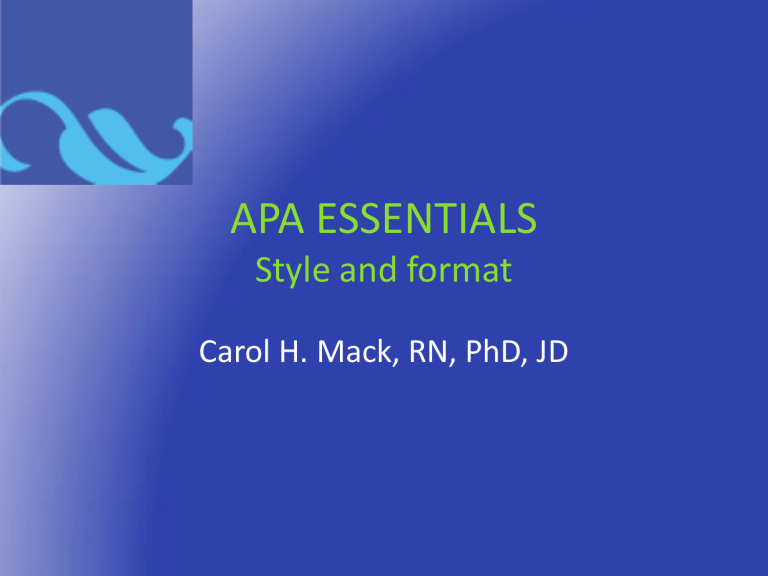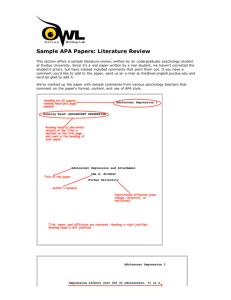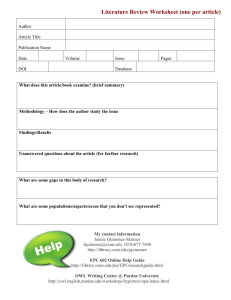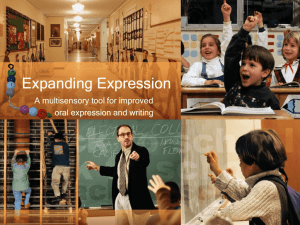Academic presentation for college course (textbook design)

APA ESSENTIALS
Style and format
Carol H. Mack, RN, PhD, JD
The APA Publication Manual
• Journal article in 1929,
Last revised 2009
• Sets standards for scientific communication
• Aims to enhance dissemination of knowledge
APA STYLE
Point of View
Use third person point of view rather than using first person or the passive voice
I found out that . . . ( first person )
The study showed that . . . ( third person )
Brought to you by the Purdue Online Writing Lab
(owl.english.purdue.edu
Active Voice
Use active voice when possible
Heart disease is considered the leading cause of death in the United States. (passive)
Research points to heart disease as the leading cause of death in the United States. (active)
Researchers have concluded that heart disease is the leading cause of death in the United States. (active)
The Writing Center, University of North Carolina at Chapel Hill
Language
• Clear: be specific in descriptions and explanations
• Concise: condense information when you can
• Plain: use simple, descriptive adjectives and minimize the figurative language
Brought to you by the Purdue Online Writing Lab
(owl.english.purdue.edu
Precision
In a study of acupuncture, they found that . . .
Better:
In a study of acupuncture, researchers found that . . .
In a study of acupuncture, researchers at UCLA found that . . .
Reducing Bias
• Use preferred terms for race and ethnicity
• Put people first
– Not: Diabetics
– But: People with diabetes
• Use sexual orientation rather than sexual preference
• Age
– Girl , boy for children
– Young man , young woman for adolescents
– Older adults instead of elderly
Improving Writing Style
• Outline first
• Put aside the first draft, then
• Check for:
– An introduction, a body, and a conclusion
– Thesis sentence and transition sentences
– Clarity and conciseness
• Proofread aloud!
APA FORMAT
General APA Format
• Double-space throughout, include Reference section
• Use 1” margins on all sides
• Left justify only
• Use 12 pt. Times New Roman or similar font
• Use a page header on the upper left-hand of every page
• Number pages in upper right-hand of each page
– Title page is page 1
Title Page
Page header: Title flush left
+ Page number flush right
Title upper half of the page, centered
Name (no title or degree)
+ Affiliation
Brought to you by the Purdue Online Writing Lab
(owl.english.purdue.edu
APA Headings
Sample Headings
Acupuncture: Good for What Ails You
Lorem ipsum dolor sit amet, consectetuer adipiscing elit, sed diam nonummy nibh euismod tincidunt ut laoreet dolore magna aliquam erat volutpat. Ut wisi enim ad minim veniam, quis nostrud exerci tation ullamcorper suscipit lobortis nisl ut aliquip ex ea commodo consequat. Duis autem vel eum iriure dolor in hendrerit in vulputate velit esse molestie consequat, vel illum dolore eu feugiat nulla facilisis at vero eros et accumsan et iusto odio dignissim qui blandit praesent luptatum zzril delenit augue duis dolore te feugait nulla facilisi.
History
Antiquity
Ut wisi enim ad minim veniam, quis nostrud exerci tation ullamcorper suscipit lobortis nisl ut aliquip ex ea commodo consequat. Duis autem vel eum iriure dolor in hendrerit in vulputate velit esse molestie consequat, vel illum dolore eu feugiat nulla facilisis at vero eros et accumsan et iusto odio dignissim qui blandit praesent luptatum zzril delenit augue duis dolore te feugait nulla facilisi.
Middle History
Lorem ipsum dolor sit amet, consectetuer adipiscing elit, sed diam nonummy nibh euismod tincidunt ut laoreet dolore magna aliquam erat volutpat.
Title
Level 1 Heading
Level 2 Heading
Level 2 Heading
In-Text Citations
• Whenever you use a source, provide the author’s name and date of publication in parentheses
• For direct quotations, provide a page number of paragraph number
In-text citations help readers locate the cited source in the
References section of the paper.
Brought to you by the Purdue Online Writing Lab
(owl.english.purdue.edu
In-Text Citations (cont’d)
Caffeine is one of the fastest acting drugs known to man. When we drink it, almost every cell in the body, including the brain, absorbs it within minutes….Caffeine intercepts adenosine, turning [its] "I ’ m tired" message into "I ’ m wide awake."
The result is an invigorating buzz coffee drinkers crave NOT ( Sunday
Morning, 2002) BUT (“Caffeine
Nation,” 2002).
The parenthetical citation and reference list entry for a source should begin with the same word
References
Brain, M. (2007). Caffeine.
Retrieved September 2, 2007, from How Stuff Works Web site: http://health.howstuffworks.com/ caffeine.htm
Caffeine nation.
(2002, November
14). Retrieved September 2,
2007, from Sunday Morning Web site: http://www.cbsnews.com/ stories/2002/11/14/sunday/main5
29388.shtml
Owen, D. (2006). Coffee and caffeine FAQs. Retrieved
September 2, 2007, from http://coffeefaq.com/site/ node/25 www.word-crafter.net/
CompII/ APA common_mistakes.ppt
References Page
Center References at the top of the page
• Double-space reference entries
• Flush left the first line
of the entry and indent
subsequent lines
• Order entries alphabetically by the author’ssurname
Brought to you by the Purdue Online Writing Lab
(owl.english.purdue.edu
APA Reference Examples
• Wegener, D. T., & Petty, R. E. (1994). Mood management
across affective states: The hedonic contingency
hypothesis. Journal of Personality & Social Psychology,
66 , 1034-1048.
• Senior, B., & Swailes, S. (2007). Inside management teams:
Developing a teamwork survey instrument. British
Journal of Management, 18, 138-153. doi:10.1111/j.
1467-8551.2006.00507.x
• Koo, D. J., Chitwoode, D. D., & Sanchez, J. (2008). Violent
victimization and the routine activities/lifestyle of
active drug users. Journal of Drug Issues, 38,
1105-1137. Retrieved from http://
www2.criminology.fsu.edu/~jdi/
APA Reference Examples
• Wegener, D. T., & Petty, R. E. (1994). Mood management
across affective states: The hedonic contingency
hypothesis. Journal of Personality & Social Psychology,
66 , 1034-1048.
• Senior, B., & Swailes, S. (2007). Inside management teams:
Developing a teamwork survey instrument. British
Journal of Management, 18, 138-153. doi:10.1111/j.
1467-8551.2006.00507.x
• Koo, D. J., Chitwoode, D. D., & Sanchez, J. (2008). Violent
victimization and the routine activities/lifestyle of
active drug users. Journal of Drug Issues, 38,
1105-1137. Retrieved from http://
www2.criminology.fsu.edu/~jdi/
APA Reference Examples
• Wegener, D. T., & Petty, R. E. (1994). Mood management
across affective states: The hedonic contingency
hypothesis. Journal of Personality & Social Psychology,
66 , 1034-1048.
• Senior, B., & Swailes, S. (2007). Inside management teams:
Developing a teamwork survey instrument. British
Journal of Management, 18, 138-153. doi:10.1111/j.
1467-8551.2006.00507.x
• Koo, D. J., Chitwoode, D. D., & Sanchez, J. (2008). Violent
victimization and the routine activities/lifestyle of
active drug users. Journal of Drug Issues, 38,
1105-1137. Retrieved from http://
www2.criminology.fsu.edu/~jdi/
APA Reference Examples
• Wegener, D. T., & Petty, R. E. (1994). Mood management
across affective states: The hedonic contingency
hypothesis. Journal of Personality & Social Psychology,
66 , 1034-1048.
• Senior, B., & Swailes, S. (2007). Inside management teams:
Developing a teamwork survey instrument. British
Journal of Management, 18, 138-153. doi:10.1111/j.
1467-8551.2006.00507.x
• Koo, D. J., Chitwoode, D. D., & Sanchez, J. (2008). Violent
victimization and the routine activities/lifestyle of
active drug users. Journal of Drug Issues, 38,
1105-1137. Retrieved from http:// www2.criminology.fsu.edu/~jdi/
If you need help with APA
• OWL website: http://owl.english.purdue.edu
• Publication Manual of the American
Psychological Association, 6 th ed.
• http://www.apastyle.org
PLAGIARISM
Original Passage
In order to communicate effectively with other people, one must have a reasonably accurate idea of what they do and do not know that is pertinent to the communication.
Treating people as though they have knowledge that they do not have can result in miscommunication and perhaps embarrassment. On the other hand, a fundamental rule of conversation, at least according to a Gricean view, is that one generally does not convey to others information that one can assume they already have.
From Raymond S. Nickerson's "How We Know-and Sometimes
Misjudge-What Others Know: Imputing One's Own Knowledge to
Others." Psychological Bulletin 125.6 (1999): p737.
University of Southern Mississippi, University Libraries
Acceptable summary
Nickerson (1999) argues that clear communication hinges upon what an audience does and does not know. It is crucial to assume the audience has neither too much nor too little knowledge of the subject, or the communication may be inhibited by either confusion or offense (p. 737).
University of Southern Mississippi, University Libraries
Acceptable Paraphrasing
Nickerson (1999) suggests that effective communication depends on a generally accurate knowledge of what the audience knows. If a speaker assumes too much knowledge about the subject, the audience will either misunderstand or be bewildered; however, assuming too little knowledge among those in the audience may cause them to feel patronized
(p.737).
University of Southern Mississippi, University Libraries
Summary or Plagiarism?
For effective communication, it is necessary to have a fairly accurate idea of what our listeners know or do not know that is pertinent to the communication. If we assume that people know something they do not, then miscommunication and perhaps embarrassment may result (Nickerson, 1999).
University of Southern Mississippi, University Libraries
Plagiarism
In order to communicate effectively with other people,
For effective communication is necessary to have a fairly
, it one must have a reasonably accurate idea of what they do and do not know that is pertinent to the communication. Treating accurate idea listeners that is of what our know or do not know pertinent to the communication. If we assume people as though they have knowledge that they do not have can result in miscommunication and that people know something they do not, then miscommunication perhaps
and embarrassment perhaps embarrassment . result (Nickerson, 1999).
University of Southern Mississippi, University Libraries may
Strategies for Avoiding
Plagiarism
• Put in quotations everything that comes directly from the text—especially when taking notes
• Paraphrase, being sure not to just rearrange or replace a few words
– Write out the idea in your own words
• Check your paraphrase against the original text
– Be sure you have not accidentally used the same phrases or words and that the information is accurate
Indiana University




